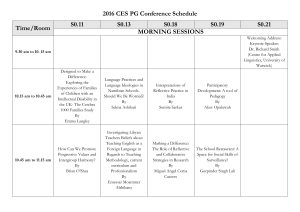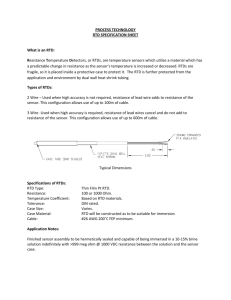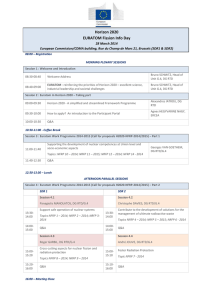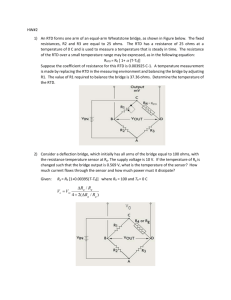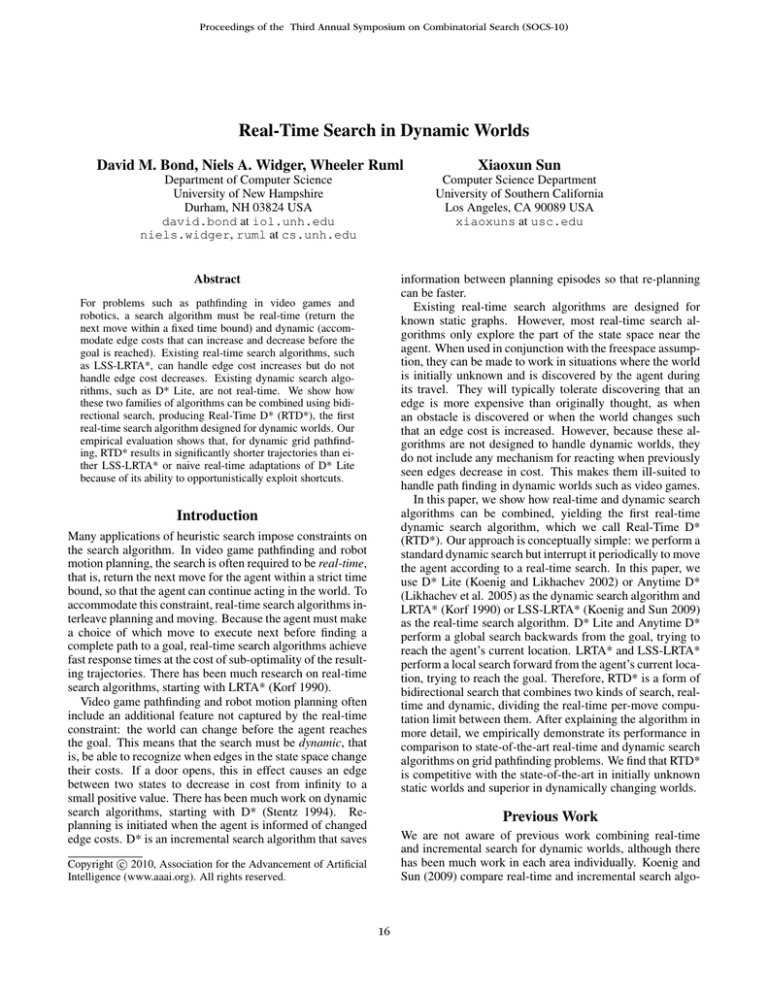
Proceedings of the Third Annual Symposium on Combinatorial Search (SOCS-10)
Real-Time Search in Dynamic Worlds
David M. Bond, Niels A. Widger, Wheeler Ruml
Xiaoxun Sun
Department of Computer Science
University of New Hampshire
Durham, NH 03824 USA
david.bond at iol.unh.edu
niels.widger, ruml at cs.unh.edu
Computer Science Department
University of Southern California
Los Angeles, CA 90089 USA
xiaoxuns at usc.edu
Abstract
information between planning episodes so that re-planning
can be faster.
Existing real-time search algorithms are designed for
known static graphs. However, most real-time search algorithms only explore the part of the state space near the
agent. When used in conjunction with the freespace assumption, they can be made to work in situations where the world
is initially unknown and is discovered by the agent during
its travel. They will typically tolerate discovering that an
edge is more expensive than originally thought, as when
an obstacle is discovered or when the world changes such
that an edge cost is increased. However, because these algorithms are not designed to handle dynamic worlds, they
do not include any mechanism for reacting when previously
seen edges decrease in cost. This makes them ill-suited to
handle path finding in dynamic worlds such as video games.
In this paper, we show how real-time and dynamic search
algorithms can be combined, yielding the first real-time
dynamic search algorithm, which we call Real-Time D*
(RTD*). Our approach is conceptually simple: we perform a
standard dynamic search but interrupt it periodically to move
the agent according to a real-time search. In this paper, we
use D* Lite (Koenig and Likhachev 2002) or Anytime D*
(Likhachev et al. 2005) as the dynamic search algorithm and
LRTA* (Korf 1990) or LSS-LRTA* (Koenig and Sun 2009)
as the real-time search algorithm. D* Lite and Anytime D*
perform a global search backwards from the goal, trying to
reach the agent’s current location. LRTA* and LSS-LRTA*
perform a local search forward from the agent’s current location, trying to reach the goal. Therefore, RTD* is a form of
bidirectional search that combines two kinds of search, realtime and dynamic, dividing the real-time per-move computation limit between them. After explaining the algorithm in
more detail, we empirically demonstrate its performance in
comparison to state-of-the-art real-time and dynamic search
algorithms on grid pathfinding problems. We find that RTD*
is competitive with the state-of-the-art in initially unknown
static worlds and superior in dynamically changing worlds.
For problems such as pathfinding in video games and
robotics, a search algorithm must be real-time (return the
next move within a fixed time bound) and dynamic (accommodate edge costs that can increase and decrease before the
goal is reached). Existing real-time search algorithms, such
as LSS-LRTA*, can handle edge cost increases but do not
handle edge cost decreases. Existing dynamic search algorithms, such as D* Lite, are not real-time. We show how
these two families of algorithms can be combined using bidirectional search, producing Real-Time D* (RTD*), the first
real-time search algorithm designed for dynamic worlds. Our
empirical evaluation shows that, for dynamic grid pathfinding, RTD* results in significantly shorter trajectories than either LSS-LRTA* or naive real-time adaptations of D* Lite
because of its ability to opportunistically exploit shortcuts.
Introduction
Many applications of heuristic search impose constraints on
the search algorithm. In video game pathfinding and robot
motion planning, the search is often required to be real-time,
that is, return the next move for the agent within a strict time
bound, so that the agent can continue acting in the world. To
accommodate this constraint, real-time search algorithms interleave planning and moving. Because the agent must make
a choice of which move to execute next before finding a
complete path to a goal, real-time search algorithms achieve
fast response times at the cost of sub-optimality of the resulting trajectories. There has been much research on real-time
search algorithms, starting with LRTA* (Korf 1990).
Video game pathfinding and robot motion planning often
include an additional feature not captured by the real-time
constraint: the world can change before the agent reaches
the goal. This means that the search must be dynamic, that
is, be able to recognize when edges in the state space change
their costs. If a door opens, this in effect causes an edge
between two states to decrease in cost from infinity to a
small positive value. There has been much work on dynamic
search algorithms, starting with D* (Stentz 1994). Replanning is initiated when the agent is informed of changed
edge costs. D* is an incremental search algorithm that saves
Previous Work
We are not aware of previous work combining real-time
and incremental search for dynamic worlds, although there
has been much work in each area individually. Koenig and
Sun (2009) compare real-time and incremental search algo-
c 2010, Association for the Advancement of Artificial
Copyright Intelligence (www.aaai.org). All rights reserved.
16
updates its g value based on its rhs value, propagates the
new g value to its successors and adds any newly inconsistent states to the priority queue and deletes newly consistent
states from the priority queue. D* Lite terminates when two
conditions hold: the key of the top state in the priority queue
is greater than or equal to the key of the start state and the
start state is consistent.
Anytime D* (AD*) is an anytime version of D* Lite that
returns increasingly shorter solutions by starting with a high
weight and lowering it over time, eventually converging to
the optimal solution (Likhachev et al. 2005). AD* caches
work across searches with different weights to speed up
planning.
rithms in static worlds with initially unknown worlds. Before presenting our approach, we will first briefly discuss
algorithms in each area, as they form the ingredients of our
method.
LRTA* chooses moves by performing a bounded lookahead search from the current state towards the goal state at
each iteration (Korf 1990). To prevent the agent from becoming stuck in local minima, it updates the h value of the
current state before moving by backing up the minimum h
value of the search frontier. Korf focuses on using breadthfirst search for the lookahead, although he mentions a variant
that uses A*, called Time Limited A* (TLA*) (Korf 1990).
Local Search Space LRTA* (LSS-LRTA*) is a state-ofthe-art variant of LRTA* that uses an A*-based lookahead
and updates the h values of all states in its lookahead
space using Dijkstra’s algorithm after the lookahead phase
(Koenig and Sun 2009). Because it updates all values in
the local search space, it learns more quickly than LRTA*.
It then moves the agent to the state on the search frontier
with the lowest f value before undertaking further lookahead, thereby expanding fewer nodes per agent move than
LRTA*.
D* Lite is a state-of-the-art incremental search algorithm
that computes a shortest path between the agent and the goal
by searching backwards from the goal towards the current
state of the agent (Koenig and Likhachev 2002). D* Lite’s
first search is exactly an A* search. Because it searches towards the current location of the agent, D* Lite can reuse
much of its previous search computation even if the agent
moves. When edge costs change, D* Lite efficiently replans
a new shortest path. We refer to this as a planning episode.
We explain D* Lite in some detail, as we will refer to these
details later.
For each state, D* Lite maintains a g value (distance to the
goal) and an rhs value (a one-step lookahead distance estimate). The rhs value of a state always satisfies the following
relationship (Invariant 1):
0
if s = sgoal
rhs(s) =
mins0 ∈Succs(s) (g(s0 ) + c(s0 , s)) otherwise
Real-Time D*
Real-Time D* (RTD*) is a bidirectional search algorithm
that combines a local search and a global search. The local search is performed around the current location of the
agent and the global search is performed from the goal towards the agent’s current location. The local search is used
to make what we term a partially informed step choice when
the global search has not yet reached the agent’s location.
When the agent is following a complete path to the goal as
found by the global search we say that it is making a fully
informed step choice. RTD* is different from other realtime search algorithms due to the addition of a global search.
Performing a global search along with a local search allows
RTD* to process changed edge costs that occur outside of
the local search’s lookahead space and therefore allows it
to find shortcuts. Performing the local search along with a
global search allows RTD* to always return an action within
bounded time, even if a complete solution path has not yet
been found.
In this paper, we consider LRTA* or LSS-LRTA* as our
local search algorithm and D* Lite or AD* as our global
search algorithm. It is easiest to understand RTD* as a modification of the global search algorithm, which is made realtime by two changes. First, we add computation limits, specified in terms of state expansions. RTD* takes a parameter,
LocalRatio, that specifies the fraction of the per-step computation limit to reserve for the local search. The rest is used
by the global search. Second, we change action selection to
depend on whether the global search phase completed naturally or was terminated by the computation limit. If it completed naturally, it computed a complete path from the agent
to the goal and we can therefore move the agent by taking
the first action from the path. Otherwise, we perform the local search and move the agent based on its computed action.
These two changes do not destroy the desirable properties of
D* Lite or AD*, as we will discuss below.
Figure 1 shows the pseudocode of RTD* using D* Lite as
its global search algorithm. sstart is the agent’s current location and sgoal is the goal location. U is the priority queue,
g(s) is the current distance estimate from s to the agent’s current location, rhs(s) is the one-step lookahead distance estimate from s to the agent’s current location (as in D* Lite)
and c(s, s0 ) is the cost from s to s0 (s and s0 are arbitrary
states). We have excluded the TopKey, CalculateKey, and
A state s is considered ‘inconsistent’ if g(s) 6= rhs(s).
D* Lite performs its search by maintaining a priority
queue similar to A*’s open list. The priority queue always
contains exactly the set of inconsistent states (Invariant 2).
D* Lite sorts the priority queue in ascending order by the
key:
min(g(s), rhs(s)) + h(s); min(g(s), rhs(s))
The priority of a state in the priority queue is always the
same as its key (Invariant 3). Thus the queue is sorted similarly to A*’s open list.
The algorithm begins by initializing the g and rhs values
of all states to ∞, with the exception that the rhs value of
the goal state is set to zero. It then adds the goal state to the
priority queue with a key of [h(goal); 0]. Thus, when the algorithm begins, the goal state is the only inconsistent state.
The main loop of the algorithm continually removes the top
state from the priority queue (the one with the smallest key),
17
1. function ComputeShortestPath(GlobalLimit, sstart )
2.
while ( U .TopKey() < CalculateKey(sstart )
OR rhs(sstart ) > g(sstart ) )
3.
if (GlobalLimit = 0) then
return EXPANSION LIMIT REACHED
4.
GlobalLimit ← GlobalLimit − 1
5.
kold ← U .TopKey()
6.
u ← U .Pop()
7.
if (kold < CalculateKey(u)) then
8.
U .Insert(u, CalculateKey(u))
9.
else if (g(u) > rhs(u)) then
10.
g(u) ← rhs(u)
11.
for all s ∈ Pred(u) UpdateVertex(s)
12.
else g(u) ← ∞
13.
for all s ∈ Pred(u) ∪{u} UpdateVertex(s)
14. if(rhs(sstart ) = ∞) then return NO PATH EXISTS
15. else return COMPLETE PATH FOUND
20. function Main(ExpandLimit, sstart , sgoal , LocalRatio )
21. LocalLimit ← LocalRatio × ExpandLimit
22. GlobalLimit ← ExpandLimit − LocalLimit
23. slast ← sstart
24. Initialize()
25. status ← ComputeShortestPath(GlobalLimit, sstart )
26. while (sstart 6= sgoal )
27.
sstart ← ChooseStep(sstart , LocalLimit, status)
28.
km ← km + h(slast , sstart )
29.
Slast ← sstart
30.
if changed edge costs then
31.
for all u in changed vertices
32.
for all v in Succ(u)
33.
UpdateEdgeCost(u, v)
34.
UpdateVertex(u)
35.
status ← ComputeShortestPath(GlobalLimit, sstart )
36. return GOAL LOCATION REACHED
16. function ChooseStep(sstart , LocalLimit, status)
17. if (status = EXPANSION LIMIT REACHED) then
return LocalSearch(LocalLimit)
18. else if (status = COMPLETE PATH FOUND) then
return mins0 Succ(s) (c(sstart , s0 ) + g(s0 ))
19. else if (status = NO PATH EXISTS) then return sstart
37. function UpdateVertex( V ertex )
38. if (u eqsgoal )
39.
rhs(u) ← mins0 Succ(V ertex) (c(V ertex, s0 ) + g(s0 ))
40. if (u U )
41.
U.Remove(Vertex)
42. if g(Vertex) neq rhs(Vertex)
43.
U.Insert(Vertex, CalculateKey(Vertex))
44. function CalculateKey( V ertex )
45. return [min(g(s), rhs(s)) + h(sstart , s) + km ;
min(g(s)), rhs(s))]
Figure 1: Pseudocode for RTD* using D* Lite.
Initialize functions from the pseudocode—they remain unchanged from the D* Lite pseudocode. TopKey returns the
key [∞, ∞] if U is the empty set. km is a bound on key
values that D* Lite uses to avoid frequent heap reordering.
The most important changes to note from the original D*
Lite algorithm are on line 3 where we altered the ComputeShortestPath termination condition and on line 27 where
we added the step choice. On line 21 and 22 we divide
the total computation limit per iteration (expansion limit)
between the local (LocalLimit) and global (GlobalLimit)
search algorithms using the LocalRatio parameter. Line 16
shows the action selection function. On line 18, we make
our step choice in the case where ComputeShortestPath terminated normally. We take the first action from the complete
solution by tracing the start state’s best successor according
to the computed g values. Line 17 handles the case where
ComputeShortestPath has terminated early due to the computation limit. At this point we run the local search algorithm with its computation limit and take its returned step.
One can plug LRTA*, LSS-LRTA* or any other local search
algorithm in here. On line 19 we handle the case where
no path currently exists between the agent’s current location
and the goal. In this case we do not move the agent since the
world may be dynamic and the agent may be able to reach
the goal at a later time. This could be altered to return a
‘path not found’ error depending on the domain.
On line 35, ComputeShortestPath is called even if no
changes in edge costs have been detected. This is because if
ComputeShortestPath previously terminated due to the com-
putation limit, the global search must continue. If ComputeShortestPath terminated normally this will have no effect unless there have been changes in the world since ComputeShortestPath will terminate immediately.
Properties of RTD*
Completeness Because RTD* follows D* Lite closely, it
can inherit many of the same properties. In static finite
worlds in which the goal is reachable from all states, RTD*
is complete, meaning it will return a valid solution resulting in the agent reaching the goal state, provided that the
computation limit is high enough. To show this, we start by
establishing the similarity with D* Lite:
Theorem 1 Invariants 1–3 of D* Lite also hold in RTD*.
Proof: There are several changes made to D* Lite in adapting it for use with RTD*: 1) action selection may be chosen according to the local real-time search (line 17), 2) the
planning phase may now terminate due to the expansion
limit (line 3), and 3) km is updated and ComputeShortestPath is called even if changes have not occurred. No part
of the proofs of D* Lite’s invariants rely on how the agent’s
moves are chosen, so change 1 is irrelevant. Change 2 means
that the agent may move during what would have been, in
plain D* Lite, a single call to ComputeShortestPath. We
need to confirm that the km update of change 3 is enough
to ensure that D* Lite’s invariants are restored after the
agent’s movement and before we re-enter ComputeShortestPath. Now, the agent’s movement does not change the g
18
or rhs values or the contents of the priority queue, so invariants 1 and 2 are preserved. Invariant 3 depends on the
priority queue keys. The first element of each key is analogous to A*’s f value and refers to g(s)(distancef romgoal)
and h(sstart , s)(remainingdistancetostart). Movement
of the agent due to change 2 changes sstart , so the keys
become obsolete. Change 3 addresses this using the same
mechanism of D* Lite, namely km , an upper bound on how
much the first key element can have decreased. There is
nothing in the proof of correctness of the km mechanism that
depends on ComputeShortestPath having found a complete
path. Hence change 3 ensures that we preserve invariant 3
in the face of change 2.
Under certain assumptions, the completeness of D* Lite
is preserved in RTD*:
on incomplete information, it cannot make any guarantees
on single trial solution optimality. In the limit of an infinite
computation bound, the global search phase will always terminate naturally and RTD* will behave like D* Lite, always
taking the next step along a path to the goal that is optimal
given its current knowledge of the world.
Time Complexity Assuming the number of successors of a
state is bounded, the time complexity of RTD* in relation
to a single step is constant, meaning RTD* returns an action within a fixed expansion limit independent of the size
of the world. RTD* limits its computation by imposing a
limit on the number of expansions per planning phase. With
a priority queue implemented as a heap, RTD* fails to be
real-time. While a logarithmic growth rate may be acceptable for many applications, to ensure the real-time property,
one can replace the heap with a bucketed hash table based on
f values. This amortizes the time for insertions (Björnsson,
Bulitko, and Sturtevant 2009; Sun, Koenig, and Yeoh 2008;
Bulitko et al. 2008).
The overall time complexity of RTD* is directly proportional to the number of planning phases until the global
search frontier intersects the agent’s current state. Once this
occurs, the algorithm has a complete path and can execute
actions without further search until the world changes. An
important property of D* Lite is that it finds shortest paths
and that its first search is exactly an A* search. Therefore,
in a static world with an infinite computation limit, RTD*
converges to A*, expanding the minimum number of nodes
while finding the shortest path.
Space Complexity The space complexity of RTD* is equivalent to that of D* Lite and A*, namely linear in the size of
the state space. (Note that in many pathfinding problems,
the state space is the same size as the map, which is usually
stored explicitly.)
Theorem 2 In a static and finite world in which the goal
is reachable from all states, if the computation limit is sufficiently large, repeated calls to ComputeShortestPath will
eventually compute g values allowing a complete path from
sstart to sgoal to be traced if one exists.
Proof: (sketch) By Theorem 1, the invariants hold, therefore in the absence of an expansion limit, RTD* performs
exactly like the original D* Lite and the original proofs also
go through.
With an expansion limit, the difference from D* Lite is
that the agent may move, obsoleting key values in the priority queues and necessitating additional expansions to update
those key values (lines 7–8). If the expansion limit is larger
than the number of necessary update expansions, then the
additional expansions performed by RTD* will behave like
ordinary D* Lite expansions and serve to enforce consistency (lines 9–13). When the world is static, both g and rhs
values will strictly decrease (lines 10 and 39). This means
that every node will be expanded a finite number of times.
Because there will always be a node on a path to sstart in the
queue, this implies that sstart will eventually be reached. Theorem 2 implies that, in a static finite world, the global
search will eventually reach the agent, resulting in a path
to the goal. Interestingly, the properties of the local search
algorithm in RTD* are not vital to its completeness in this
case, permitting the use of arbitrary domain-dependent enhancements in the local search. Completeness is more difficult to prove in an infinite world without making an assumption that the agent is moving towards the search frontier.
RTD* is not complete in dynamic worlds; however, this
is an unavoidable property of dynamic search algorithms.
Consider a situation where the agent is trapped in a room.
While a door to the north always provides an exit from the
room, there are two southern doors that are much closer to
the agent. Each is equipped with a sensor such that, whenever the agent approaches, the door shuts temporarily. While
the agent always has a way out by going north, any conventional dynamic search algorithm will guide the agent to
toggle between the two southern doors forever. In general,
without a model of the changes to the world it appears difficult to see how a dynamic algorithm could guarantee completeness.
Optimality If an algorithm must recommend a step based
Empirical Evaluation
To evaluate whether RTD* performs well in practice, we
compared it against the real-time search algorithms LRTA*
and LSS-LRTA*.1 We also compared against two naive
baseline algorithms based on D* Lite. The first, called RTD*
NoOp, trivially obeys the real-time constraint by issuing
‘no-op’ actions as necessary until the global D* Lite search
terminates with a complete solution. The degree to which
RTD* outperforms this NoOp variant illustrates the benefit
gained from using a local search to interleave reactive action with deliberative planning. The second naive baseline,
called Non-RTD*, is not real-time and is always allowed unlimited computation per step. Its performance illustrates the
theoretical best-possible planning given the agent’s evolving
state of knowledge if the freespace assumption holds.
We evaluate these algorithms in two settings: pathfinding
in worlds where the world is initially unknown to the agent
but does not change over time and pathfinding in worlds that
1
Just before press time, we noticed a small bug in our RTD*
implementation: km was only updated when edge costs changed
(eg, line 30 of Figure 1 appeared before line 28). Limited experiments with a corrected implementation showed only very minor
performance changes in our test domains.
19
Figure 2: Example grids used for pathfinding in initially unknown static (left) and dynamic (right) worlds.
are known to the agent but that change over time. The worlds
are modeled as grids with eight-way movement and the algorithms use octile distance as the heuristic. Movement along
the four
√ cardinal directions has unit cost and the diagonals
cost 2. All actions are reversible. The grid itself consists
of cells that are either passable or impassable.
In our experiments we used a number of values for
RTD*’s LocalRatio parameter LocalRatio: 25%, 50%, and
75%. We display the best performing ratio in our results.
The differences in the performance of the ones not shown
were small.
Unknown Static Worlds
In these worlds, the grid is initially unknown to the agent,
but it can observe obstacles in a radius of 7 cells around
itself (an arbitrarily chosen value). As it moves around the
grid, it learns which cells are impassable. The agent assumes
a cell is passable until it discovers otherwise. Once the agent
sees the true state of a cell, the cell will not change. Because
any changes the agent detects are inside its field of vision
and therefore close to it, they are likely to have an immediate
effect on its current step.
We used three 161 × 161 cell grid maps from the popular
game Warcraft (Figure 2, left). The start and end locations
were randomly selected such that a valid path is guaranteed
to exist, resulting in 519 problems. We tested at computation
limits of 1, 8, 16, 32, 64, 128, 256 and 512 expansions per
step.
The top graph in Figure 3 shows the performance of
LRTA* (with TLA* lookahead), RTD* (using D* Lite and
LRTA* with a LocalRatio of 25%), and the two baseline
algorithms RTD* NoOp and Non-RTD*. The y axis represents the time steps used by the agent, where a time step
represents one opportunity for the agent to move. All algorithms except RTD*NoOp move at every time step; for
those algorithms this is equal to the distance traveled by the
agent. Time is expressed relative to the trajectory of an agent
guided by A* with full knowledge of the world and no computation limit. The x axis represents the total per-step computation limit, expressed in node expansions, and is on a
logarithmic scale. Note that Non-RTD* does not obey the
computation limit and thus appears as a straight line in the
plot.
In the top graph, RTD* shows strong performance, outperforming the other real-time algorithms. LRTA* has decent performance for small computation limits but its slow
learning causes it to improve more slowly than the other al-
Figure 3: Results on pathfinding in initially unknown world,
showing sub-optimality versus per-step expansion limit.
gorithms when given more time. RTD*NoOp shows enormous improvement as the expansion limit is increased because it can move more frequently, however it still performs
very poorly. RTD* outperforms RTD* NoOp, confirming
that taking a partially informed step is better than not moving at all during deliberation since not moving is implicitly
increasing the time to reach the goal. As expected, in the
limit of infinite computation time RTD* approaches the performance of Non-RTD*.
The bottom graph in Figure 3 presents the results of a
similar experiment using a more modern real-time search. It
shows LSS-LRTA*, RTD* (using D* Lite and LSS-LRTA*
with a LocalRatio of 75%), and the two baseline algorithms
RTD* NoOp and Non-RTD*. LSS-LRTA* performs much
better than LRTA*, but RTD* yields almost identical performance, even though the world is not truly dynamic.
Dynamic Worlds
To test the algorithms in dynamic worlds, we created a simple benchmark domain using a 100 × 100 cell grid divided
into rectangular rooms (Figure 2, right). The start location
was fixed at the upper left hand corner and the goal was fixed
in the lower right hand corner. Each room has up to four
open ‘doors’ that lead to an adjacent room. The doors open
and close randomly as time passes, causing paths to become
20
putation limit increases, the difference in performance becomes larger. The ability to react to new shortcuts offers
strong benefits in this domain.
The bottom graph of Figure 4 shows LSS-LRTA* and
two versions of RTD*, one using D* Lite and LSS-LRTA*
and the other using Anytime D* (AD*) and LSS-LRTA*.
Both used a LocalRatio of 50%. AD* used a starting weight
of 3, decreasing when possible by 0.5, and increasing when
necessary by 0.1. The graph shows that RTD* using D*
Lite and LSS-LRTA* is slightly worse than LSS-LRTA* on
low computation limits but outperforms it significantly for
higher limits. This performance gap eventually becomes
constant because, at high computation limits, LSS-LRTA*
converges to the performance of an A* search that assumes
a static world, and RTD* converges to the performance of
D* Lite.
When used with AD*, RTD* exhibits improved performance at smaller computation limits, surpassing LSSLRTA*.
Once LSS-LRTA* sees a wall, it learns the increased h
values for the states around that wall. However, in a dynamic world with decreasing edge costs, when a shortcut
opens up LSS-LRTA*’s learning may guide the agent away
from a shortcut. In contrast, RTD* will notice the opening of a shortcut and replan accordingly. RTD* outperforms
LSS-LRTA* on dynamic worlds because of its ability to take
advantage of shortcuts. This will hold true as long as the
changes in the world are infrequent enough to give the RTD*
frontier sufficient time to reach the agent.
Figure 4: Results on pathfinding in dynamic worlds, showing sub-optimality versus per-step expansion limit.
Discussion
RTD* is the first real-time search algorithm specifically designed for dynamic worlds. RTD* outperforms existing realtime search algorithms, such as LRTA* and LSS-LRTA*, on
dynamic worlds, but is also competitive on unknown worlds.
Because the algorithm is relatively simple, it should be easy
to adapt it to use new dynamic and real-time algorithms that
are developed in the future.
For video games, having agents move in a believable manner is important. While we have not conducted quantitative
tests of agent ‘naturalness’, we believe that RTD* should be
able to produce more believable behavior than LSS-LRTA*.
Shortcuts that open up outside of the local search lookahead
space are not taken advantage of by existing real-time algorithms. The addition of a global search allows RTD* to
direct the agent towards such shortcuts.
Most real-time searches are ‘agent-centered,’ in that they
focus the search of the agent near its current location. Time
Bounded A* (TBA*) is a recent proposal that separates the
agent’s search from its location (Björnsson, Bulitko, and
Sturtevant 2009). It performs an A* search from the start to
the goal, periodically moving the agent along the path to the
best node on A*’s open list in order to comply with the realtime constraint. RTD* was inspired in part by this separation
of search and agent movement, and we initially attempted to
combine TBA* with Lifelong Planning A* (LPA*) (Koenig,
Likhachev, and Furcy 2004) in order to handle dynamic
worlds. However, we found the TBA* approach to be fundamentally limited because TBA*’s search proceeds from
available or invalidated as the agent traverses the map. The
openings and closings were randomly generated while ensuring that there was always a path from any location to the
goal and then recorded to ensure the same dynamism for
each algorithm. 100 different sequences of changes were
used. Note that the world is fully observable, so agents
are notified when changes occur. The movement costs and
heuristic used were the same as in our experiments on unknown worlds, and we tested the same computation limits.
As we did with unknown worlds, we ran a baseline NonRTD* algorithm that does not obey the real-time constraint,
in order to gain a sense of the best achievable performance.
We do not show results for our other naive baseline, RTD*
NoOp, because it doesn’t make sense for dynamic worlds.
For many computation limits, RTD* NoOp never moves the
agent because the global search is too busy tracking updates
to the world and never reaches the agent’s start state.
The top graph of Figure 4 shows the performance of
LRTA* (with TLA* lookahead) and RTD* (using D* Lite
and LRTA* with a LocalRatio of 25%). For the y axis, which
again shows the distance traversed, we normalized against
the optimal trajectory length computed off-line by A*, assuming that all doors were open.
As can be seen in the graph, RTD* outperforms LRTA*
on all but the very lowest computation limits. As the com-
21
the initial start to the goal, ignoring the agent’s current location. If the agent’s path back to the start becomes impassable, it can become impossible for it to intersect with the
global search. Thus we chose to search from the goal to the
agent, as in D* Lite.
It is important to note that RTD* is not an anytime algorithm. Whereas an anytime algorithm determines complete
trajectories that improve over time, RTD* must often make
a partially informed step choice based on incomplete trajectories.
In our evaluation, we followed standard practice in the
real-time search literature of measuring the per-step computation limit using the number of node expansions. While this
provides some isolation from implementation- and machinedependent code tuning, it does ignore the fact that different algorithms have different overhead. D* Lite and AD*
(and thus RTD*) perform a global search using an open list
data structure, that can be burdensome to maintain. LSSLRTA* performs Dijkstra’s algorithm from the lookahead
fringe, which is not considered as node expansion. While
these effects may be inconsequential in complex real-world
domains where node expansion and heuristic calculation is
the dominant cost, they may be significant in a simple domain such as video game pathfinding.
the global search used by RTD* is able to direct the agent towards these shortcuts when a local search would not.
Acknowledgments
We are indebted to Sven Koenig for very helpful suggestions
on earlier drafts of this work. We also thank Nathan Sturtevant for providing the Warcraft game maps, Brad Larsen for
the adversarial doors example, and NSF (grant IIS-0812141)
and the DARPA CSSG program for support.
References
Björnsson, Y.; Bulitko, V.; and Sturtevant, N. R. 2009.
TBA*: Time-Bounded A*. In IJCAI, 431–436.
Bulitko, V.; Lustrek, M.; Schaeffer, J.; Björnsson, Y.; and
Sigmundarson, S. 2008. Dynamic Control in Real-Time
Heuristic Search. J. Artif. Intell. Res. (JAIR) 32:419–452.
Koenig, S., and Likhachev, M. 2002. D* Lite. In AAAI/IAAI,
476–483.
Koenig, S., and Sun, X. 2009. Comparing Real-Time and Incremental Heuristic Search for Real-Time Situated Agents.
Autonomous Agents and Multi-Agent Systems 18(3):313–
341.
Koenig, S.; Likhachev, M.; and Furcy, D. 2004. Lifelong
Planning A*. Artif. Intell. 155(1-2):93–146.
Korf, R. E. 1990. Real-Time Heuristic Search. Artif. Intell.
42(2-3):189–211.
Likhachev, M.; Ferguson, D. I.; Gordon, G. J.; Stentz, A.;
and Thrun, S. 2005. Anytime Dynamic A*: An Anytime,
Replanning Algorithm. In ICAPS, 262–271.
Stentz, A. 1994. Optimal and Efficient Path Planning for
Partially-Known Environments. In ICRA, 3310–3317.
Sun, X.; Koenig, S.; and Yeoh, W. 2008. Generalized Adaptive A*. In AAMAS, 469–476.
Conclusion
By combining real-time and dynamic search in a bidirectional framework, we have created the first real-time dynamic search algorithm, Real-Time D* (RTD*). We presented empirical results comparing it against LRTA*, LSSLRTA*, and two naive baseline versions of D* Lite on both
unknown and dynamic worlds. The results show that RTD*
is comparable to the state-of-the-art in unknown worlds
and it performs better than the state-of-the-art in dynamic
worlds. This is because, in dynamic worlds, the ability to use
shortcuts as they open up is crucial to good performance, and
22

